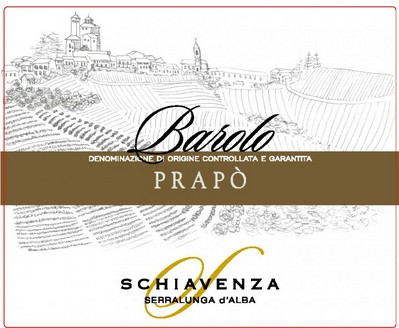 Schiavenza Barolo Prapò– organic
Schiavenza Barolo Prapò– organic
“If you are looking for a classic Serralunga Barolo that offers structure for long-term cellaring, the wines from Schiavenza are ideal candidates. Traditional in the winemaking, each Barolo is an excellent representation of its site, from the Serralunga commune bottling to Broglio, Ceretta, and Prapò. The wines are rugged in nature, but never aggressive, and are beautifully made with great restraint and harmony.” – Tom Hyland, Forbes
“This is a strong set of wines from Schiavenza. The wines come across as better balanced than in the past, with a more refined approach to extraction….the wines appear to be moving in a very positive direction.” – Antonio Galloni, Vinous
The local Piemontese dialect for sharecropper is “schiavenza,” and this much-buzzed about estate takes its name from the sharecroppers who formerly worked the property’s vineyards during the time that it functioned as a hospital and school as part of the Opera Pia Barolo (you can think of the Opera Pia Barolo as a similar entity to the Hospices du Beaune). Brothers Vittorio and Ugo Alessandria revitalized this property in the mid 1950’s when it was in need of such work, and things are thriving under the current second generation, with farming and winemaking led by son-in-laws Luciano Pira and Walter Anselma.
A name like Schiavenza should give one a clue as to the style here; this is a “traditional to the bone” property with a foundation of organic farming and Slavonian botte, nothing more and nothing less. Vineyard holdings have expanded over time, and the estate is made up of ten hectares split between Serralunga and Monforte. These include the heralded crus Prapò, Bricco Cerretta, and Broglio.
Schiavenza is located in Serralunga d’Alba in the heart of Piedmont’s Langhe district, celebrated for its great Barolo vineyards. The estate was founded in 1956 by the brothers Vittorio and Ugo Alessandria; the estate and surrounding area were formerly part of the Opera Pia Barolo (a castle that is kind of like the Hospices du Beaune: part educational institution and part hospital) whose vineyards were traditionally worked by sharecroppers. The local dialect for sharecropping is schiavenza. Today, the estate is run by the second-generation Alessandria sisters, Enrica and Maura, and their husbands Luciano Pira and Walter Anselma. Their holdings include 8.95 hectares in Serralunga with a small 0.5ha plot in Monforte d’Alba, and include the heralded crus Prapò, Cerretta, and Broglio. For the last 19 years, they have also run Trattoria Schiavenza, right in the middle of the village of Serralunga. It is perennially recognized in Slow Food’s Osterie d’Italia guide for its excellent traditional fare, which draws in both local winemakers and tourists.
In the vineyard, they do not use pesticides or herbicides. Cover crops such as clover and mustard greens are planted to achieve balance and limit yields naturally. Harvest is manual and is conducted according to the phases of the moon. In the cellar, they use only naturally occurring yeasts, and ferment the wines in cement cisterns, with 20-25 days of maceration. In terms of aging, the wines see extended time in the traditional large 3000-3600L Slavonian oak casks called botti. Tasting the three crus side by side, one realizes what Schiavenza is all about. All three crus are on the east side of the Serralunga ridge, so exposures are all same, to the southeast. Yields are more or less the same. Cellar treatment (fermentation, length of maceration, vessel, and length of aging) is all the same. The differences one feels have only to do with the variations in cru and vintage.
Over the last few vintages, Schiavenza has made some subtle but effective changes in the cellar. There is a gentler approach to extraction and when the press wine is used, it comes from their new, delicate hydraulic vertical basket press. The length of aging in botte for the Barolos has also been reduced, coming down to around 30 months wheareas it had previously been 36+ months. Getting the wines into bottle earlier has helped preserve the fruit for the long haul.
Schiavenza’s 0.9 hectares in the Prapò cru are located at 350m above sea level, with southeast exposure; the vines were planted in 1993. Of all their crus, this is the one in which the soil is most representative of Serralunga: its high percentage of light-colored limestone naturally limits yields and results in wines that need time in bottle to show their best.
The grapes are destemmed and crushed. Fermentation occurred spontaneously in cement vats, with maceration lasting 20-25 days with pump-overs. After malolactic, the wine was racked into used Slavonian oak botte of 3500-4000L and aged there for 36 months. It was bottled unfined/unfiltered and bottle aged for 6 months before release.
94 points, Jeb Dunnuck: “The 2017 Barolo Prapo parcel is 0.9 hectares at 350 meters elevation. With the highest proportion of limestone soils, it provides the most structure of the Schiavenza wines. The Prapo is more introverted aromatically, with licorice, balsamic, and baked cherry. The structure is balanced and firm, warranting time in cellar to soften its grip. Brooding with tobacco, cherry pit, and stony minerality, the Prapo is classic, dark fruited and grounded. Drink 2024-2042.”


